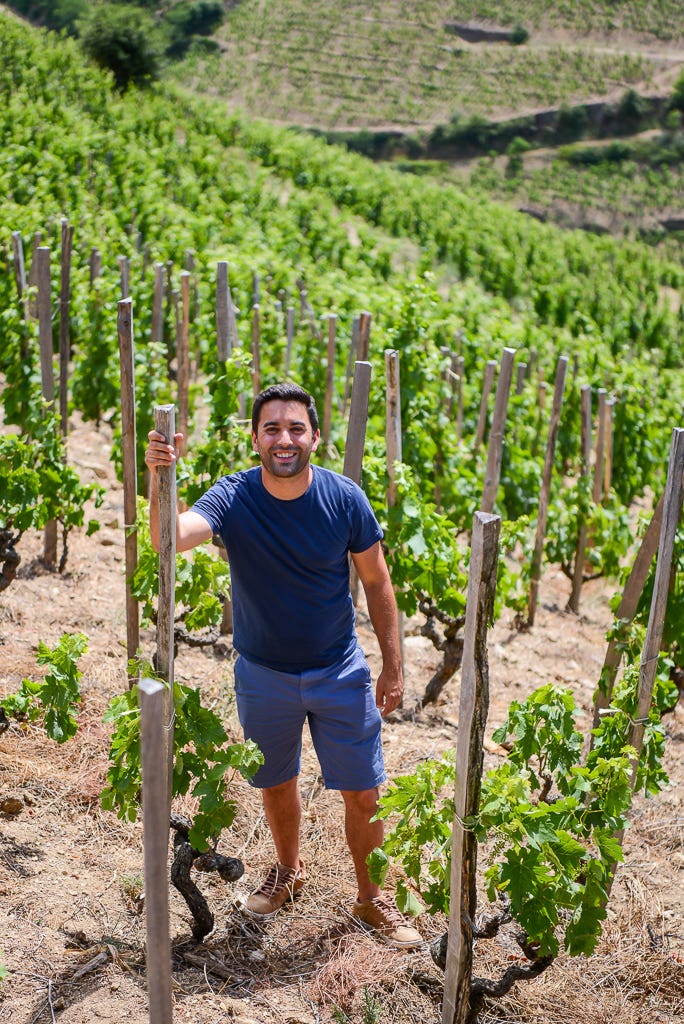Thomas Farge
In Saint-Jean-de-Muzols, somewhat hidden, lies the Domaine Guy Farge. Directly at the foot of the steep flanks of Saint-Joseph, - the largest contiguous appellation of the northern Rhône. The domaine has excellent steep slopes in Saint-Joseph, Cornas, Condrieu and Saint-Péray, as well as some promising IGP areas, and has grown to an impressive 20 hectares over the years.
Thomas Farge took over his father's estate in 2018 and has been doing great things ever since.


Granite
The northern Rhône, that is granite. The eastern foothills of the Massif Central, a huge granite rock, mainly determine the soil structure. The rock is very old and shows different forms of weathering in different places. Granite consists of different minerals, such as mica, feldspar or quartz, which in turn decompose at different rates. Thus, over the millennia, a diverse mix of soil types has developed, eroded by exposure to the sun, the great differences in temperature, wind and rain.
The Heart and Soul
In a way, Saint-Joseph is the heart and soul of the Northern Rhône. The original core area of Saint-Joseph comprised six communes: Glun, Mauves, Tournon, Lemps, Saint-Jean-de-Muzols and Vion. And a small outstanding single vineyard, "lieux-dit Saint-Joseph" north of Mauves gave the appellation its name back then. Other famous single vineyard sites are: Le Paradis, Le Clos and Vignes de l'Hospice. Another 20 communes were then added when the appellation was expanded in 1969, and the original cultivation area of Saint-Joseph increased from 97 to around 1400 hectares today.
Family Affairs
The history of Domaine Guy Farge begins as early as 1920, in the then core area of the appellation, in the commune of Saint-Jean-de-Muzols. Henri Farge bought 12 hectares of land at that time and delivered his grapes to the local cooperative until Guy Farge, at that time still production manager of the cooperative Cave de Tain, decided to press his own wine from his grapes. With his knowledge and ambition, Guy Farge realised his life's project as the completion of his ancestors' path, combining his work as a craftsman and his respect for nature and tradition.
In 2018, his eldest son Thomas Farge took over the winery, and began to work even harder according to ecological and sustainable principles, pushing ahead with the conversion to organic viticulture.
Sustainability
Standing in the small car park in front of the domaine, you have to bend your head quite a bit, and stagger slightly, in awe. For only manual labour is possible on these steep slopes. For Thomas Farge, it was already clear when he took over that the work in the vineyard and cellar should be done according to organic guidelines, and he gradually reshaped Domaine Farge so that with the 2021 vintage, all wines are certified organic. All work is based on the lunar calendar, because the moon's gravitational pull influences the flow of juice in the vines, among other things, and therefore determines the time for gentle pruning. Bottling also takes place on optimal days.
Finesse
Thomas Farge's wines are consistently finesse-rich and elegant, and his white Saint-Josephs are highly regarded in French gastronomy. However, they mainly produce red wine from 100 % Syrah. No other red grape variety is allowed in the northern Rhône. And the white wines consist mainly of Roussanne, Marsanne and Viognier. The white parade varieties of the region. His IGP Collines Rhodaniennes, Bouquet de Syrah and Bouquet de Blanc, come from a small parcel outside the village of Lubac at 400 metres above sea level.
A clear vision
Thomas Farge is constantly busy and highly focused. He is always refining his signature since the takeover, and it may well be that the line-up of wines will change and focus even further. Thomas Farge has a clear, modern vision in mind, and smaller joint ventures, such as the "Oxymore" project, which was created together with Stéphane Usseglio from Domaine Raymond Usseglio in Châteauneuf-du-Pape to deal with the increasingly hot years and rising alcohol levels, are also broadening his horizons and enthusiasm.
It is not only the French gastronomy or Rhône freaks who have an increased interest in the region. In this country, too, it is no longer a secret that the wines of the Northern Rhône are experiencing a small renaissance. This is due, among other things, to a small group of top producers like Thomas Farge, who are helping the region with new ideas and a clear vision of the future to produce elegant, fresh wines with a strong character and a clear reference to the terroir.
(this text is a copy of my work as Wine Buyer for Tesdorpf GmbH, Thomas Farge's wines are available for purchase there: Domaine Farge auf Tesdorpf.de)






